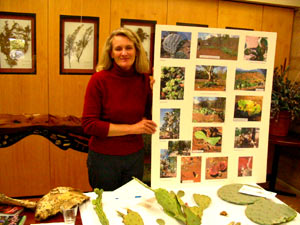'WHEN THE GARDEN GOES FERAL | | Lorraine Edmunds; Photo: Bruce Leane |
When the Garden Goes Feral was the title of a presentation given by Ms Lorraine Edmunds on Saturday 22 May at the WMC Herbarium Room at the Australian Arid Lands Botanic Garden.
Ms Edmunds showed slides and video and gave a talk on the problem of the Prickly Pear (Opuntia stricta) and the Wheel Cactus (Opuntia robusta) in the Flinders Ranges to the Friends of the AALBG.
Lorraine is a part time co-ordinator working with the Blinman community to fight the growing menace of the cactus by raising awareness of the problem, train people in the use of sprays, and assist in the control the pear, and prepare submissions for funding to help in a situation that is becoming desperate and where governments are disinterested.
It is thought that the cactus was first introduced into NSW in early days of settlement to host the Cochineal insect that in turn was used for dye to make the red coats worn by soldiers. The Opuntia is a native of Mexico where it is grown for food. The fruit is succulent and used in jams and other foods. Even in Australia it is deemed a useful food. The creatures of the wild have also discovered the pear as a great source of food and have played a large part of its virulent spread in the Flinders.
In Queensland in the 1920s the pear infested 25 million hectares of land rendering it useless. The moth Cactoblastis cactorum was imported from Mexico to control the pear. Within 6 years the land had been reclaimed as farms. It is feared that if there is no check on the plant the Flinders will suffer the same fate as QLD and NSW.
While Cactoblastis was effective in the wetter more humid climate of QLD it is not effective in the hot dry climate of the Flinders. The Cochineal insect also helps in biological control but not to the degree of Cactoblastis.
For effective control and eradication, expensive and highly toxic sprays must be used such as Grazon and Garlon. The drawback in dealing with the pear is inaccessible terrain. In some cases helicopters have been used to drop spray and equipment on hilltops where there are concentrated infestations. Usage of helicopters is again very expensive.
Tourists to the area have noticed the spread of the pear. They enquire if it is a native of the area and are concerned that there is hardly any interest in the fact that the plant in being allowed to spread.
Ms Edmunds believes that, Unless halted now the cactus will change the Flinders Ranges as we know them, forever. Gwen Leane |
